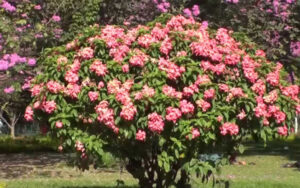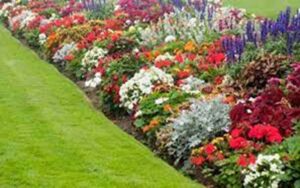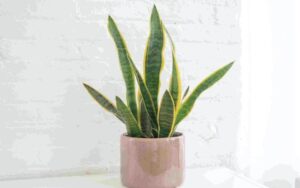HELICONIA : The Bold and the Beautiful
Mr. Vinod Thomas
Founder
Green Brigade Horticulture
Kerala
Heliconia plants are a stunning addition to any garden or indoor space. These accent plants boast colorful flowers and unique foliage that are sure to catch anyone’s attention. Although they require some specific care, they are generally easy to look after and can be propagated with ease. Whether you’re an experienced gardener or a novice, Heliconia plants are definitely worth considering for your plant collection.
Belonging to the family Heliconiaceae, Heliconia plants are a group of approximately 200 species. They are related to bananas and ginger, sharing some common characteristics such as tall, upright stems with large, broad leaves that spiral around them. Heliconia is the only genus in the monotypic family Heliconiaceae, confirmed as distinct, and places them in the order Zingiberales.
![]()
Heliconia plants are renowned for their beautiful flowers that come in a range of vivid colors, including red, orange, yellow, and pink, often adorned with unique patterns or markings. The shape, size, and color of the flowers vary depending on the particular Heliconia species. The colorful part of the flower is actually a modified leaf or bract. These flowers are produced on long, upright or drooping panicles, and comprise of waxy, brightly colored bracts that encase small, true flowers. Due to their unique shape, the flowers often attract only a specific subset of hummingbirds in the region, who are able to pollinate them. Heliconia flowers also contain a generous amount of nectar that serves to attract these birds.
Heliconia plant enthusiasts commonly use terms like “lobster claw,” “parrot’s beak,” or “pleated fan” to describe the unique shapes of their flowers. As tropical plants, Heliconia prefer a relatively high and consistent temperature. While a handful of hardier varieties can tolerate cooler weather, most Heliconia types thrive best in semi-tropical or tropical climates, making them a great option for outdoor gardening all year long.
The Basics of Good Heliconia Plant Care
Heliconia plants are bold and exotic, adding a unique flair to any outdoor space, be it a yard, garden or patio setting. Their foliage ranges in shades from bright lemon yellow to deep burgundy, while their substantial blossoms are hard to miss. The flower bracts come in a variety of shapes – some stiff and upright, while others hang in pendulous spirals. These plants grow from rhizomes, which allow them to quickly spread in ideal growing conditions. Additionally, they offer some value in areas that require protection from erosion. Due to their preference for consistently moist soil, they are suitable for low-lying areas of the landscape where other plants may be at risk of root rot.
Heliconia plants are non-woody and, like banana plants, they have a pseudo stem made of leaf petiole sheaths that overlap to provide support for the leaves and flowers. Each stem produces flowers only once, and after flowering is complete, the pseudo stem dries up and collapses, leading to the death of the stem. It is advisable to cut back the entire pseudo stem when the flowers start to fade, to help the plant conserve energy and to maintain a neat appearance. Although some varieties prefer full sun, they typically thrive in partial shade, which is closer to their natural setting. In the wild, they are typically found in forest clearings where they receive bright, dappled sunlight. Heliconia plants also grow well along river banks, where they can receive ample sun and consistent water.
Heliconia Growing Conditions
Like all plants the Heliconia will do best when given the right conditions. Let’s take a look at what they need to make them thrive.
Keep the Soil Light, Airy and Rich
These plants thrive in a well-draining soil and generously enriched with decaying organic matter, which provides a natural source of nourishment. A combination of leaf compost, garden loam and a bit of sand makes a planting mix rich in nutrients and resists becoming compacted.
Provide Ample Light for Vigorous Flowering
Although heliconia grow in forests in the wild, remember that they choose to be in clearings where they will receive a minimum of six hours of bright light daily. This is necessary for abundant and constant flowering. When kept in lower light, the plants produce lots of lush leaves but fewer flowers. Lower light also causes plants to gain more height as they reach for the sun.
Provide Ample, Consistent Watering
Heliconia likes to be watered, and the soil should be kept consistently and uniformly moist. In very hot climates, you may need to water a couple of times daily. Water at ground level rather than spraying the plants as splashing water can carry fungal spores to the leaves causing damage. If you find you have a problem with root rot as indicated by curling leaves and/or brown leaves, it is an indication your soil is not light and airy enough. Amend it to create a more freely draining soil mixture. Keep in mind that this watering routine does not apply to freshly planted rhizomes. Remember that they can be subject to root rot because they do not yet have any foliage and flowers to drink up excess water.
Heliconias Love Fertilizer
Some growers do not fertilize, choosing instead to supply nourishment through different types of organic fertilizers to build a soil rich in organic matter. A large plant with lots of blooms will consume a great deal of fertilizer. For consistent feeding of average sized plants, best fertilizer for heliconia is a good quality, slow time-release fertilizer with an NPK ratio of 2-1-2 is a good choice.
Pruning and Maintaining Your Heliconia
Heliconia plants do not require a lot of pruning. They shape themselves, and since the leaves are long fronds, several feet in length, trimming them is not necessary or desirable. When you do remove a leaf, you should remove it entirely. If your plants have so many leaves that make it difficult to see the flowers, completely remove the obstructing leaves by cutting them all the way back. When cutting flowers from smaller varieties, cut them off at ground level as this allows more light into the beds and encourages side shoot growth. Thoroughly remove damaged or dead leaves, and trim away dead flower stems entirely. To do this, cut them back as near to the ground as you can. When the stump has dried up, remove the remainder with your fingers.
Pests and Diseases
Healthy wild heliconia planted outdoors have little or no trouble with pests. Some growers note that ants like to travel about on the plants and enjoy the nectar of the flowers, but they don’t seem to do any harm. Birds may damage the plants a bit, but sharing with them won’t cause too much harm. Rats may eat various parts of the plant in which case traps may have to be set and the rodents neutralized. Take care not to harm beneficial life!
Propagation of Heliconia
It is rare to propagate these plants by seed as doing so is a lengthy process which gives varying results. Most nurseries and vendors of Heliconia rhizomes offer the rhizome area with roots, which are easy to plant and grow. Just follow these steps:
1. Dip the segments into a mild fungicidal solution.
2. Plant in a free-draining soil mixture with the tip (bud or eye) of the rhizome just barely exposed.
3. Firm the soil lightly around the rhizome and add more if needed.
4. Water moderately till sprouting of leaves
Select the Right Variety for Your Setting
When considering Heliconia plants, it is important to carefully select the right variety for your space to ensure it fits in gracefully and does not overpower your garden. Some of the larger species can reach heights of fifteen feet or more, making them better suited as a houseplant for a single season. Dwarf varieties, on the other hand, stay small and can make wonderful houseplants for many years, growing up to a foot and a half to three feet high. It’s also important to keep bloom time in mind, as all Heliconia are long blooming but some, like Heliconia psittacorum, bloom year-round, making them even more desirable as houseplants.
Heliconia Varieties
These are some of the varieties of heliconia under which there are various types which exhibit distinct flower shapes, sizes and colors.
Heliconia Psittacorum
![]() Commonly known as Parakeet Flower, it is the most popular type of Heliconia. There is a great deal of choice to be had within this easy-to-grow variety. The plant is relatively compact, ranging from one to five feet high. Bract colors vary, and you may find orange, red, cream colored and multi-colored bracts on the same plant.
Commonly known as Parakeet Flower, it is the most popular type of Heliconia. There is a great deal of choice to be had within this easy-to-grow variety. The plant is relatively compact, ranging from one to five feet high. Bract colors vary, and you may find orange, red, cream colored and multi-colored bracts on the same plant.
Heliconia Angusta
![]() Heliconia Angusta is commonly called the Christmas heliconia because its red and white inflorescences and you can count on festive color as this plant produces pinkish-red bracts with green and white sepals. Under ideal conditions, it can grow to four feet high. This is a shade loving variety, so it is a great choice as a houseplant or as a container plant on a shaded deck or patio.
Heliconia Angusta is commonly called the Christmas heliconia because its red and white inflorescences and you can count on festive color as this plant produces pinkish-red bracts with green and white sepals. Under ideal conditions, it can grow to four feet high. This is a shade loving variety, so it is a great choice as a houseplant or as a container plant on a shaded deck or patio.
Heliconia Bourgeana
![]() They are larger plants attaining heights ranging from four to six feet. These showy plants produce dramatic bracts of flowers in red, crimson and pink with a black distal lip. The shoots and main stalk are also quite dramatic in a deep shade of purple. These plants require full sun and are an excellent choice for a large, outdoor garden in a tropical setting.
They are larger plants attaining heights ranging from four to six feet. These showy plants produce dramatic bracts of flowers in red, crimson and pink with a black distal lip. The shoots and main stalk are also quite dramatic in a deep shade of purple. These plants require full sun and are an excellent choice for a large, outdoor garden in a tropical setting.
Heliconia Bihai
![]() This heliconia is grown for spectacular flowers and tropical foliage. It is native to South America but grown extensively in India now. This large plant’s banana-like leaves grow directly from thick, quickly spreading rhizomes or underground, lateral stems. This is the perfect plant to impart a tropical look to any landscape.
This heliconia is grown for spectacular flowers and tropical foliage. It is native to South America but grown extensively in India now. This large plant’s banana-like leaves grow directly from thick, quickly spreading rhizomes or underground, lateral stems. This is the perfect plant to impart a tropical look to any landscape.
Heliconia Caribeae
![]() The plants range in height from seven to fifteen feet. Its leaves are similar to those of banana plants and can reach five feet long. The plant produces immense, erect bracts in red and/or yellow and blossom clusters in white with greenish tips. Flowers come in all colors and shades. These plants prefer full sun, but they can tolerate as much as sixty percent shade.
The plants range in height from seven to fifteen feet. Its leaves are similar to those of banana plants and can reach five feet long. The plant produces immense, erect bracts in red and/or yellow and blossom clusters in white with greenish tips. Flowers come in all colors and shades. These plants prefer full sun, but they can tolerate as much as sixty percent shade.
Heliconia Rostrata
![]() Commonly known as the “Hanging Lobster Claw”, it is very popular because of its colorful, unusual inflorescences. This plant produces large, pendulous, bright red blooms in dazzlingly yellow bracts that can reach lengths of three feet. When kept in a container, it usually grows to between 4 and 5 feet
Commonly known as the “Hanging Lobster Claw”, it is very popular because of its colorful, unusual inflorescences. This plant produces large, pendulous, bright red blooms in dazzlingly yellow bracts that can reach lengths of three feet. When kept in a container, it usually grows to between 4 and 5 feet
Heliconia Vellerigera
![]() A truly spectacular hanging flower species. It is a medium sized heliconia, reaching 6-10 feet tall. The leaves are light purple on the underside. The flowers are covered with a type of spider like hairs. It blooms throughout the year.
A truly spectacular hanging flower species. It is a medium sized heliconia, reaching 6-10 feet tall. The leaves are light purple on the underside. The flowers are covered with a type of spider like hairs. It blooms throughout the year.
Heliconia Chartacea
![]() Heliconia Chartacea are characterized by its large, pendulous and colorful bracts, which can be red, yellow, orange, or pink, and they are arranged in a spiral pattern along the stem. The plant can grow up to 3 meters tall and requires a warm, humid climate to thrive. They are a popular choice for landscaping and is often used
Heliconia Chartacea are characterized by its large, pendulous and colorful bracts, which can be red, yellow, orange, or pink, and they are arranged in a spiral pattern along the stem. The plant can grow up to 3 meters tall and requires a warm, humid climate to thrive. They are a popular choice for landscaping and is often used
Heliconia Orthotricha
![]() It is a medium-sized heliconia that grows up to 4-6 feet tall and produces erect inflorescences with showy bracts that range in color from green to yellow to orange. They have a covering of fine, silvery hairs that give them a velvety texture. The plant is popular as an ornamental in tropical gardens and as a cut flower for floral arrangements.
It is a medium-sized heliconia that grows up to 4-6 feet tall and produces erect inflorescences with showy bracts that range in color from green to yellow to orange. They have a covering of fine, silvery hairs that give them a velvety texture. The plant is popular as an ornamental in tropical gardens and as a cut flower for floral arrangements.
Heliconia Griggsiana
![]() Heliconia Griggsiana is a medium-sized heliconia that can grow up to 3-4 meters tall and produces pendulous flowers with bright red and yellow bracts. The bracts of Heliconia griggsiana are tubular and overlap to form a spiral pattern around the stem, creating a striking and colorful display.
Heliconia Griggsiana is a medium-sized heliconia that can grow up to 3-4 meters tall and produces pendulous flowers with bright red and yellow bracts. The bracts of Heliconia griggsiana are tubular and overlap to form a spiral pattern around the stem, creating a striking and colorful display.
Heliconia Collinsiana
![]() Heliconia collinsiana is a large heliconia that can grow up to 6 meters tall. The bracts of Heliconia collinsiana are yellow-green, with red margins and tips, and are arranged in a spiral pattern along the stem. They have waxy white stems and undersides of leaves with long, pendulous bracts. It is a nice feature plant
Heliconia collinsiana is a large heliconia that can grow up to 6 meters tall. The bracts of Heliconia collinsiana are yellow-green, with red margins and tips, and are arranged in a spiral pattern along the stem. They have waxy white stems and undersides of leaves with long, pendulous bracts. It is a nice feature plant
Heliconia Longissima
![]() It is a tall heliconia that can grow up to 6 meters and produces pendulous inflorescences with red bracts. The bracts of Heliconia longissima are long and narrow are arranged alternately on wavy rachis. The yellow flowers are half-hidden inside the showy bracts.
It is a tall heliconia that can grow up to 6 meters and produces pendulous inflorescences with red bracts. The bracts of Heliconia longissima are long and narrow are arranged alternately on wavy rachis. The yellow flowers are half-hidden inside the showy bracts.
Heliconia Lingulata
![]() It is a medium-sized heliconia that can grow up to 3 meters tall and produces erect inflorescences with bright red and yellow bracts. The bracts of Heliconia lingulata are narrow and elongated, with a curved or twisted shape, and are arranged in a spiral pattern along the stem.
It is a medium-sized heliconia that can grow up to 3 meters tall and produces erect inflorescences with bright red and yellow bracts. The bracts of Heliconia lingulata are narrow and elongated, with a curved or twisted shape, and are arranged in a spiral pattern along the stem.
Heliconia Champneiana
![]() It is a medium to large-sized heliconia that can grow up to 5 meters tall and produces erect inflorescences with colorful bracts. The bracts of Heliconia champneiana are red and yellow with speckles on them, giving the plant its distinctive “splash” pattern. An unusual looking heliconia.
It is a medium to large-sized heliconia that can grow up to 5 meters tall and produces erect inflorescences with colorful bracts. The bracts of Heliconia champneiana are red and yellow with speckles on them, giving the plant its distinctive “splash” pattern. An unusual looking heliconia.
Heliconia Stricta
![]() It is one of the smaller heliconia with bright red flower bracts with dark or light flashy edges. Makes a great under storey plant in tropical gardens. . The plant typically reaches a height of 1 – 1.5 meters, and has paddle-shaped leaves that can grow up to 60cm in length.
It is one of the smaller heliconia with bright red flower bracts with dark or light flashy edges. Makes a great under storey plant in tropical gardens. . The plant typically reaches a height of 1 – 1.5 meters, and has paddle-shaped leaves that can grow up to 60cm in length.
Heliconia Xanthovillosa
![]() The most amazing heliconia to date! Bracts are pendant and bright yellow to yellow-green with silvery yellow woolly hairs covering the entire bract. It is a showstopper for any garden. Brilliant yellow hairs cover this angular pendent beautifully.
The most amazing heliconia to date! Bracts are pendant and bright yellow to yellow-green with silvery yellow woolly hairs covering the entire bract. It is a showstopper for any garden. Brilliant yellow hairs cover this angular pendent beautifully.
Heliconia Latispatha
![]() Heliconia latispatha grows up to 6 ft tall, with leaves resembling those of bananas. Inflorescence is erect, with red or orange bracts subtending green, yellow or orange flowers. What is nice about this Heliconia is how the blooms appear at the very top of the stalk, shown off above all the leaves.
Heliconia latispatha grows up to 6 ft tall, with leaves resembling those of bananas. Inflorescence is erect, with red or orange bracts subtending green, yellow or orange flowers. What is nice about this Heliconia is how the blooms appear at the very top of the stalk, shown off above all the leaves.
Commercial Value
Heliconia plants and flowers have great commercial potential in India due to their unique and exotic appearance, as well as their versatility in use. In India some varieties are being cultivated for cut flowers and landscapes. Here are some potential commercial prospects for Heliconia plants and flowers in India:
![]()
Floriculture: Heliconia flowers are often used in the floriculture industry for their bright colors and unusual shape. They can be used in floral arrangements, bouquets, and as cut flowers. The demand for unique and exotic flowers is increasing in India, making heliconia flowers a popular choice among florists and customers.
Landscaping: Heliconia plants are also used for landscaping in parks, gardens, and other public spaces. They can add a tropical touch to the landscape and are easy to maintain. The demand for landscaping services is increasing in India due to the growth of the real estate sector and urbanization, making heliconia plants a valuable addition to any landscaping project.
Medicinal Properties: Heliconia plants have been found to have medicinal properties and are used in traditional medicine for treating various ailments. The extract from heliconia flowers has been found to have anti-inflammatory, antifungal, and antioxidant properties.
















